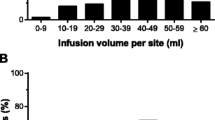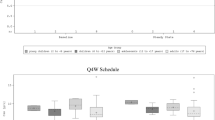Abstract
Background
Flebogamma® 10% DIF represents an evolution of intravenous immune globulin from the previous 5% product to be administered at higher rates and with smaller infusion volumes. Pathogen safety is enhanced by the combination of multiple methods with different mechanisms of action.
Objective
The objective of this study as to evaluate the efficacy, pharmacokinetics, and safety of Flebogamma® 10% DIF for immunoglobulin replacement therapy in primary immunodeficiency diseases (PIDD).
Methods
Flebogamma® 10% DIF was administered to 46 subjects with well-defined PIDD at a dose of 300–600 mg/kg every 21–28 days for 12 months.
Results
Serious bacterial infection rate was 0.025/subject/year. Half-life in serum of the administered IgG was approximately 35 days. No serious treatment-related adverse event (AE) occurred in any patient. Most of the potentially treatment-related AEs occurred during the infusion, accounting for 20% of the 601 infusions administered.
Conclusions
Flebogamma® 10% DIF is efficacious and safe, has adequate pharmacokinetic properties, and is well-tolerated for the treatment of PIDD.

Similar content being viewed by others
References
Berger M. A history of immune globulin therapy, from the Harvard crash program to monoclonal antibodies. Curr Allergy Asthma Rep. 2002;2:368–78.
Eibl MM. History of immunoglobulin replacement. Immunol Allergy Clin North Am. 2008;28:737–64.
Outbreak of hepatitis C associated with intravenous immunoglobulin administration—United States, October 1993–June 1994 (1994) MMWR Morb Mortal Wkly Rep 43:505–509
Kempf C, Stucki M, Boschetti N. Pathogen inactivation and removal procedures used in the production of intravenous immunoglobulin. Biologicals. 2007;35:35–42.
Horowitz B, Wiebe ME, Lippin A, Stryker MH. Inactivation of viruses in labile blood derivatives. 1. Disruption of lipid-enveloped viruses by tri-(n-butyl) phosphate detergent combinations. Transfusion. 1985;25:516–22.
Korneyeva M, Hotta J, Lebing W, Rosenthal RS, Franks L, Petteway SR Jr. Enveloped virus inactivation by caprylate—a robust alternative to solvent detergent treatment in plasma derived intermediates. Biologicals. 2002;30:153–62.
Louie RE, Galloway CJ, Dumas ML, et al. Inactivation of hepatitis C virus in low pH Intravenous immunoglobulin. Biologicals. 1994;22:13–9.
Burnouf T, Radosevich M. Nanofiltration of plasma-derived biopharmaceutical products. Haemophilia. 2003;9:24–37.
O'Grady J, Losikoff A, Poiley J, Fickett D, Oliver C. Virus removal studies using nanofiltration membranes. Dev Biol Stand. 1996;88:319–26.
Soluk L, Price H, Sinclair C, Atalla-Mikhail D, Genereux M. Pathogen safety of intravenous Rh immunoglobulin liquid and other immune globulin products: enhanced nanofiltration and manufacturing process overview. Am J Ther. 2008;15:435–43.
Kumar A, Teuber SS, Gershwin ME. Current perspectives on primary immunodeficiency diseases. Clin Dev Immunol. 2006;13:223–59.
Berger M. Principles of and advances in immunoglobulin replacement therapy for primary immunodeficiency. Immunol Allergy Clin North Am. 2008;28:413–37.
Hooper J. intravenous immunoglobulins: evolution of commercial IGIV preparations. Immunol Allergy Clin North Am. 2008;28:765–78.
Jorquera JI. Flebogamma 5% DIF development: rationale for a new option in intravenous immunoglobulin therapy. Clin Exp Immunol. 2009;157(Suppl 1):17–21.
Vlug A, Nieuwenhuys EJ, van Eijk RV, Geertzen HG, van Houte AJ. Nephelometric measurements of human IgG subclasses and their reference ranges. Ann Biol Clin (Paris). 1994;52:561–7.
US FDA Compliance program guidance manual. Chapter 42—Blood and blood products inspection of source plasma establishments, brokers, testing laboratories and contractors. http://www.fda.gov/cber/cpg/7342002bld.htm. Accessed 27 December 2008
Code of Federal Regulations, Title 21, Volume7. CFR21 Part 640. April 1, 2008
Berger M, Flebogamma® 5% DIF® Investigators. A multicenter, prospective, open label, historically controlled clinical trial to evaluate efficacy and safety in primary immunodeficiency disease patients of Flebogamma 5% DIF®, the next generation of Flebogamma. J Clin Immunol. 2007;27:628–33.
Belda FJ, Otegui M, Caballero S, Domingo N, Díez JM, Gajardo R, et al. Viral safety studies of FlebogammaDIF®. Clin Exp Immunol. 2008;154:209.
US FDA. Guidance for industry: safety, efficacy and pharmacokinetic studies to support marketing of immune globulin intravenous (human) as replacement therapy for primary immune deficiency. www.fda.gov/cber/gdlns/igivimmuno.htm. Accessed 25 March 2009
Berger M, Pinciaro PJ, Flebogamma 5% Investigators. Safety, efficacy and pharmacokinetics of Flebogamma 5% for replacement therapy in primary immune deficiency. J Clin Immunol. 2004;24:389–96.
Heatherington AC, Vinci P, Golde H. A pharmacokinetic/pharmacodynamic comparison of SAAM II and PC/WinNonlin modeling software. J Pharm Sci. 1998;87:1255–63.
Official Disability Guidelines. http://www.disabilitydurations.com/pr_repmdc.htm. Accessed 25 March 2009
Centers for Disease Control and Prevention. FastStats. http://www.cdc.gov/nchs/fastats. Accessed 25 March 2009
Bonagura VR, Marchlewski R, Cox A, Rosenthal DW. Biologic IgG level in primary immunodeficiency disease: the IgG level that protects against recurrent infection. J Allergy Clin Immunol. 2008;122:210–2.
Daw Z, Padmore R, Neurath D, Cober N, Tokessy M, Desjardins D, et al. Hemolytic transfusion reactions after administration of intravenous immune (gamma) globulin: a case series analysis. Transfusion. 2008;48:1598–601.
Stein MR, Nelson RP, Church JA, Wasserman RL, Borte M, Vermylen C, et al. Safety and efficacy of PrIGIVen®, a novel 10% liquid immunoglobulin preparation for intravenous use, in patients with primary immunodeficiencies. J Clin Immunol. 2009;29:137–44.
Pierce LR, Jain N. Risks associated with the use of intravenous immunoglobulin. Transfus Med Rev. 2003;17:241–51.
Author information
Authors and Affiliations
Corresponding author
Rights and permissions
About this article
Cite this article
Berger, M., Pinciaro, P.J., Althaus, A. et al. Efficacy, Pharmacokinetics, Safety, and Tolerability of Flebogamma® 10% DIF, a High-Purity Human Intravenous Immunoglobulin, in Primary Immunodeficiency. J Clin Immunol 30, 321–329 (2010). https://doi.org/10.1007/s10875-009-9348-y
Received:
Accepted:
Published:
Issue Date:
DOI: https://doi.org/10.1007/s10875-009-9348-y




